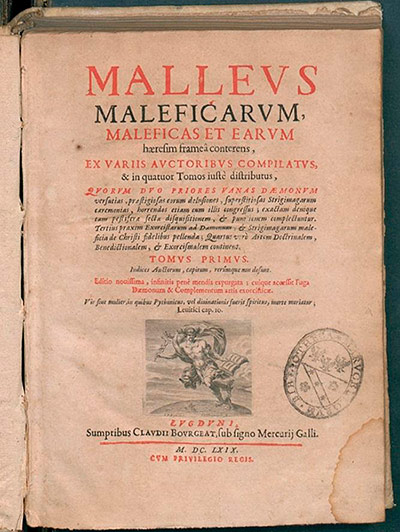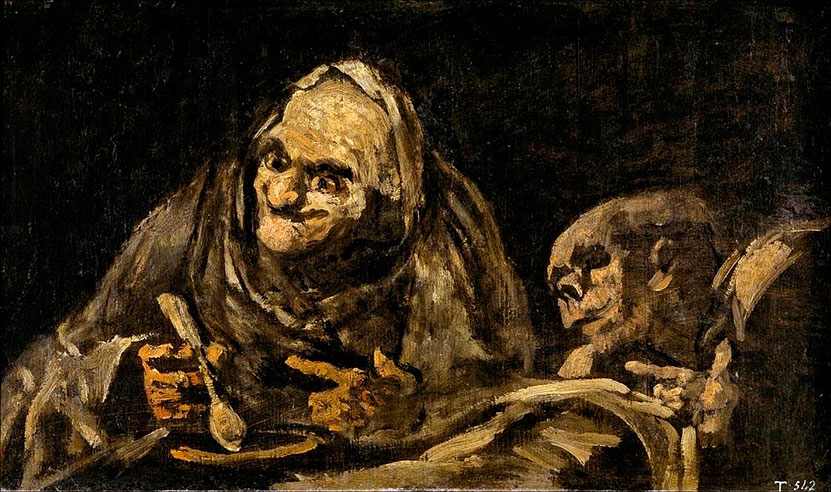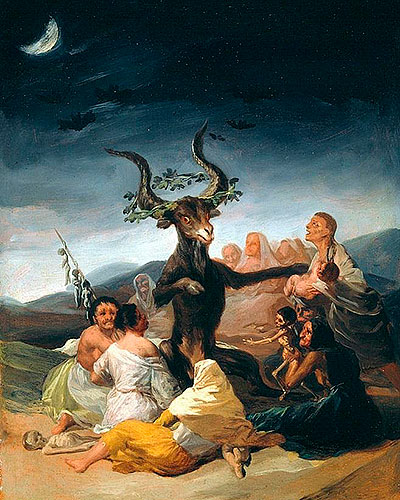Read
From Malleus Maleficarum to witches' tales
A dose of terror for Halloween week!
Paulina Laphond Payán, 3rd year student of Degree of History of the
School of Humanities and Social Sciences and author of the account @historiarte2x3,
brings us a fascinating analysis of one of the most controversial treatises in the History of the
controversial treaties in the history of the Western world.

"El Aquelarre o El Gran Cabrón" by Francisco de Goya. Wikimedia Commons. See source.
It's Halloween week and it couldn't be a better time to talk about witches: do they exist or did they exist, what were they like, what were the witch hunts about? Without a doubt, this is one of the most fascinating subjects for historians of the Modern Age.
The witch tales that immediately spring to mind are probably influenced by films, which, unlike fairy tales, always include haggard old women who ride broomsticks, make juicy potions to poison someone and wear very pointy hats. However, some of these fairy tales are not fairy tales at all, but a reality dating back to the 15th century, with some differences.
The age of witches
 |
|
BEIC Digital Library. source of the image. |
Much of the beliefs about witches are compiled in the book Malleus Maleficarum (Latin for "The Witches' Hammer") written by Jacob Sprenger and Heinrich Kramer, two German monks, in 1486.
This book was one of the most famous books during the Modern Age, as over three centuries, it became the indispensable guide for the Inquisition in the fight against witchcraft in Europe and America, which would lead to the so-called Witch Hunts.
To put it in context: the Modern Age was a time of division in Europe between Protestant monarchies and Catholic monarchies. For its part, the Holy Inquisition was founded for religious reasons in the search for the salvation of souls.
In the same way, it was established for political reasons, as its goal was to get rid of enemies within the Catholic kingdoms, which implied annihilating all traces of heresy. However, it is important to note the fact that, according to María Elvira Roca Barea, executions for witchcraft were more abundant in the Protestant context than in Spain.
At that time, as appears in an interesting article by the professor of the School of Humanities and Social Sciences of the University of Navarra Jesús María Usunáriz, witchcraft was considered a heresy and therefore a crime, which in turn threatened the security and social order of the Monarchy, as it was accompanied by horrible crimes such as the murder of the most innocent.
Victims of witchcraft
The authors of the Malleus Maleficarum related and attributed the practice of witchcraft and evil arts mostly to women, because they were supposedly strongly marked by the original sin of Eve and were more susceptible to the temptations of the devil. However, it should be noted that there were men in the inquisitorial processes tried for witchcraft, albeit to a lesser extent.
Between the 15th and 18th centuries, it could be estimated that there were between
40,000 and 60,000 death sentences for witchcraft.

"Two old men eating soup" by Francisco de Goya. Wikimedia Commons. See source.
But why were women, especially healers, the main goal in the witch hunts? According to Monter, these associations corresponded to "projections of patriarchal fears onto atypical women" (Horsley, 712). Meanwhile, Mildelfort (Horsley, 713) suggests that these women, mostly independent, could have been subjects of suspicion insofar as they could constitute disruptive elements in the rigid society of the fifteenth century.
The stereotype of the witch according to Malleus Maleficarum
As part of the witch tradition that has survived to the present day, summarises Professor Usunáriz from Richard Horsley's book, a witch was described by four main characteristics: practising maleficiumor doing harm through supernatural means, flying, attending witches' gatherings called covens and making a pact with the devil.
 |
|
"El Aquelarre" by Francisco de Goya. Wikimedia Commons. See source. |
It was also believed that witches could cause great storms, sterility in men, had a habit of eating children, and those they did not kill were offered as sacrifices to demons. They could even produce miscarriages and cause the death of bewitched men just by looking at them.
The Malleus Maleficarum holds that the purpose of all witchcraft is to effect incantations by means of a glance or any other spell.
For this there were various remedies, such as amulets for the evil eye, for example, which were distributed among society for fear of being bewitched.
Although the Malleus was very important for the dissemination of the belief in witches in society, it is also true, as Raúl Madrid, PhD in Law from the University of Navarre, points out, that "it did not produce or create, however, the concept of witchcraft, which had already been shaped fifty years earlier. Its novelty lies in its systematic nature, which helped to spread the issue in the collective mentality".
"A witch was described by four main characteristics: practising maleficium, or doing harm by supernatural means, flying, going to witches' gatherings
or doing harm by supernatural means, flying, attending witches' gatherings called covens, and having a pact with the devil,
called covens, and having a pact with the devil."
The evidence suggests that beliefs about witches shaped early modern society to a large extent. What was believed, in many cases, coincides with what has come down to our culture. The difference is that most of us take it as a simple story that appears in young children's books or fictional films.
However, in the 15th century and later, these beliefs determined the behaviour of an entire community. In cities, towns and communities, suspicion was part of everyday life. It is quite possible that the European population lived in constant fear that a single glance could ruin the whole life and even endanger the salvation of the soul after death.
Unfortunately, these accusations of witchcraft were also subject to manipulation and were used as a solution to other problems or to get even with people they wanted to get rid of for some reason.
Finally, it cannot be denied that all societies have developed a series of exaggerated myths in order to produce fear and rejection of certain social groups. In this case, it could be suggested that the myths spread by the Malleus Maleficarum were intended, on the basis of the fear of witchcraft, to alienate the Christian population from heretical acts and to invite them to come closer to the Catholic Church, whether for spiritual or political purposes.
bibliography
-
Usunariz Garayoa, J. M. (2012). Witch-hunting in modern Navarre (16th-17th centuries). University of Navarra, Pamplona, Spain. pp.306-350.
-
Richard A. Horsley (1979). Who Were the Witches? The Social Roles of the Accused in the European Witch Trials. The Journal of Interdisciplinary History Vol. 9, No. 4 (Spring, 1979), pp. 689-715 (27 pages).
-
Luzán Cervantes, O. (2009). El control eclesiástico y civil de la hechicería indígena en la Nueva España.
-
Madrid, R. (2015). The crime of witchcraft in Book Two of the Disquisitionum Magicarum by Martín del Río..
-
Sprenger, J., & Kramer, H. (2005). Malleus maleficarum (1st ed.). Latin Circle.







